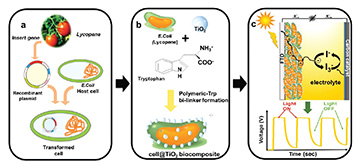Left: The UBC process begins with the cloning of E. coli to express the photosensitive pigment lycopene. Middle: The lycopene-expressing bacteria are then coated in a shell of non-covalently bonding TiO2 nanoparticles. Right: The biogenic photovoltaic material is deployed as the anode in a dye-sensitized solar cell. [Image: University of British Columbia] [Enlarge image]
Adopting solar power can be tricky, and expensive, especially in regions where cloudy skies are the norm, such as parts of Canada and Northern Europe. Now, researchers at the University of British Columbia (UBC), Canada, have devised a cheap, sustainable solar cell that relies on bacteria to convert light to energy, even in an overcast environment (Small, doi: 10.1002/smll.201800729).
Going biogenic
This is not the first attempt to build biogenic solar cells, which are made of living organisms rather than synthetic materials and allow for the production of energy with limited sunlight. But previous efforts have focused on extracting the natural dye that bacteria use for photosynthesis. That’s a very costly and complex process; moreover, the toxic solvents used in this method can cause the dye to degrade.
The UBC team took a more affordable and greener route that bypassed the extraction process altogether. First, the team genetically engineered E. coli cells to synthesize lycopene, a photosensitive pigment that absorbs light in the 380-to-520-nm range. Then, the researchers coated the bacteria with a layer of TiO2 nanoparticles, which acts as a semiconductor. Finally, the group applied the mixture to a conductive glass surface to act as the anode (along with an I–/I3– electrolyte and a graphite cathode) in a dye-sensitized solar cell.
Measuring up
The result, according to Vikramaditya Yadav, project lead and a professor in UBC’s department of chemical and biological engineering, is an exceptionally stable photovoltaic material that “could perform at comparable efficiencies as conventional solar cells.” The researchers assessed the material’s properties under experimental conditions typical for conventional photovoltaics—conditions that closely simulate outdoor sunlight—and found that the difference between bright and low light was not significant. They recorded an open-circuit potential of 0.289 V, a short-circuit current of 0.19 mA and a corresponding short-circuit density of 0.686 mA cm−2 (an improvement on the 0.362 mA cm−2 achieved by others in the field).
The UBC team suggests that this method for fast and efficient synthesis of a new class of bio-hybrid photovoltaic materials directly addresses the need for reducing the manufacturing cost of biogenic solar cells. “Our solution to a uniquely B.C. [British Columbia] problem”—that is, the prevalence of overcast skies—“is a significant step toward making solar energy more economical,” said Yadav. Through this process, the researchers estimate that they reduced the cost of dye production by approximately 90 percent compared to other biogenic solar cells, and they predict that this work could lay the foundation for a new class of bio-organic optoelectronics.
However, the team notes that there is room for improvement. Efficiency could increase through ordered deposition of the biogenic material, use of platinum as the counter electrode, minimizing dark currents, using MOF complexes as photoactivators, better matching of electrolytes and use of more light-sensitive dyes. The Holy Grail, Yadav says, would be finding a way to keep the bacteria alive throughout the process, to achieve indefinite dye production.

